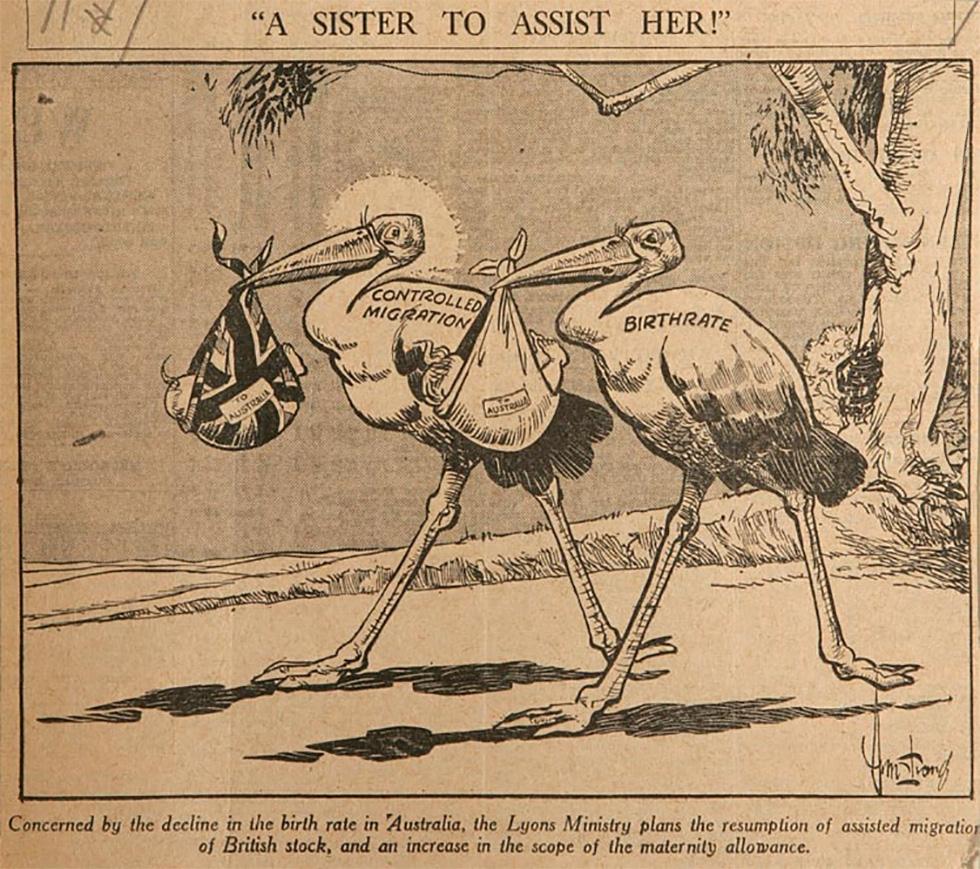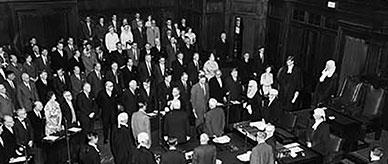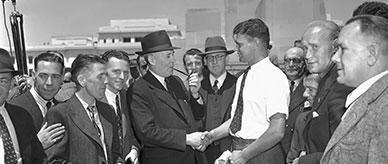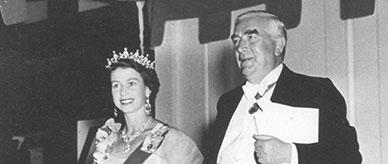


Transcript
[Heading:] "A SISTER TO ASSIST HER!"
[A drawing of two storks, each carrying a baby in a bundle. The stork on the left, labelled 'CONTROLLED MIGRATION' carries a baby wrapped in a British flag, labelled 'TO AUSTRALIA'. The stork on the right, labelled 'BIRTHRATE', carries a baby in a white cloth, labelled 'TO AUSTRALIA'. In the bottom right corner is a handwritten signature: 'Armstrong'.]
[Caption:] Concerned by the decline in the birth rate in Australia, the Lyons Ministry plans the resumption of assisted migration of British stock, and an increase in the scope of the maternity allowance.
About this record
This is a black-and-white cartoon relating to the efforts of Joseph Lyons’s United Australia Party government (1932–39) to increase the population of Australia. It shows two storks – symbols of fertility and prosperity – delivering babies, both labelled 'To Australia'. One baby is wrapped in the Union Jack. The background, with its gum tree, is distinctively Australian. The caption refers to both assisted migration and an increased scope for the maternity allowance.
Educational value
- The cartoon, dated 29 September 1937, comments on government attempts to increase the Australian population after the worst years of the Great Depression by assisting the immigration of people from Britain, which had long been regarded as the quickest and most desirable option. Previous schemes had encouraged the arrival of farm labourers, domestic workers and those with family members already living in Australia to boost the workforce.
- Joseph Lyons (1879–1939), mentioned in the cartoon caption, was the major figure in Australian federal politics in the 1930s. The tenth Australian prime minister, Lyons won elections in 1931, 1934 and 1937, serving at a time of economic crisis during the Great Depression while Australia's population was still suffering the effects of World War I. He died from a heart attack in 1939 while still in office.
- Lyons was a supporter of assisted migration; in 1936 he asked state governments to support a new migration scheme which would be smaller and would not require migrants to work on the land. He followed this with a speech titled 'More People Imperative' in 1937. Improved economic conditions gave the scheme some impetus before it was halted by the outbreak of World War II.
- Migration was considered vital for economic growth and for the defence of Australia’s shores. However, intakes fell during the Great Depression of the 1930s, contributing to a sharp decline in population growth rates. State and federal governments tended to favour 'good British stock' with a focus on younger immigrants and on those with nominations or some capital. However, the British in general did not appear keen to immigrate to Australia.
- The government also hoped that increasing the scope of the maternity allowance would assist in boosting the national birthrate, which had fallen to new lows during the Great Depression. Many women did not marry after the high male death rate of World War I, and some who did marry found they were not able to afford the food, clothing or housing required for a large family.
- Harold Barry ‘Mick’ Armstrong (1903–78), the cartoonist, had his first cartoon published in the Bulletin at the age of 16 and he continued to be an occasional contributor while working as a survey draughtsman. He later contributed gag cartoons to Smith's Weekly and Aussie and also drew political cartoons for the Melbourne Punch and the Sydney Sun, among others. He is best known for his work on The Argus during World War II.
Acknowledgments
Learning resource text © Education Services Australia Limited and the National Archives of Australia 2010.
Related themes
Need help with your research?
Learn how to interpret primary sources, use our collection and more.



